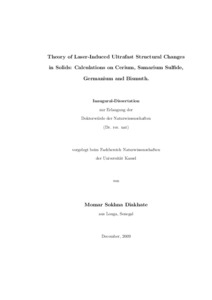| dc.date.accessioned | 2010-04-21T07:38:31Z | |
| dc.date.available | 2010-04-21T07:38:31Z | |
| dc.date.issued | 2010-04-21T07:38:31Z | |
| dc.identifier.uri | urn:nbn:de:hebis:34-2010042132586 | |
| dc.identifier.uri | http://hdl.handle.net/123456789/2010042132586 | |
| dc.description.sponsorship | Deutsche Forschungsgemeinschaft (DFG) und Universität Kassel | ger |
| dc.language.iso | eng | |
| dc.rights | Urheberrechtlich geschützt | |
| dc.rights.uri | https://rightsstatements.org/page/InC/1.0/ | |
| dc.subject | DFT | eng |
| dc.subject | Tight Binding-Theory | eng |
| dc.subject | Phase Transition | eng |
| dc.subject.ddc | 530 | |
| dc.title | Theory of laser-induced ultrafast structural changes in solids | eng |
| dc.type | Dissertation | |
| dcterms.abstract | The present thesis is a contribution to the study of laser-solid interaction.
Despite the numerous applications resulting from the recent use of laser technology, there is still a lack of satisfactory answers to theoretical questions regarding the mechanism leading to the structural changes induced by femtosecond lasers in materials.
We provide here theoretical approaches for the description of the structural response of different solids (cerium, samarium sulfide, bismuth and germanium) to femtosecond laser excitation.
Particular interest is given to the description of the effects of the laser pulse on the electronic systems and changes of the potential energy surface for the ions.
Although the general approach of laser-excited solids remains the same, the potential energy surface which drives the structural changes is calculated with different theoretical models for each material. This is due to the difference of the electronic properties of the studied systems. We use the Falicov model combined with an hydrodynamic method to study photoinduced phase changes in cerium. The local density approximation (LDA) together with the Hubbard-type Hamiltonian (LDA+U) in the framework of density functional theory (DFT) is used to describe the structural properties of samarium sulfide.
We parametrize the time-dependent potential energy surface (calculated using DFT+ LDA) of bismuth on which we perform quantum dynamical simulations to study the experimentally observed amplitude collapse and revival of coherent $A_{1g}$ phonons.
On the basis of a time-dependent potential energy surface calculated from a non-orthogonal tight binding Hamiltonian, we perform molecular dynamics simulation to analyze the time evolution (coherent phonons, ultrafast nonthermal melting) of germanium under laser excitation. The thermodynamic equilibrium properties of germanium are also reported. With the obtained results we are able to give many clarifications and interpretations of experimental results and also make predictions. | eng |
| dcterms.accessRights | open access | |
| dcterms.alternative | Calculations on cerium, samarium sulfide, germanium and bismuth | eng |
| dcterms.creator | Diakhate, Momar Sokhna | |
| dc.contributor.corporatename | Kassel, Universität, FB 18, Naturwissenschaften, Institut für Physik | |
| dc.contributor.referee | Garcia, Martin E. (Prof. Dr.) | |
| dc.contributor.referee | Pastor, Gustavo M. (Prof. Dr.) | |
| dc.subject.swd | Laser | ger |
| dc.subject.swd | Dichtefunktionalformalismus | ger |
| dc.subject.swd | Starke Kopplung | ger |
| dc.subject.swd | Phasenumwandlung | ger |
| dc.date.examination | 2009-12-17 | |

